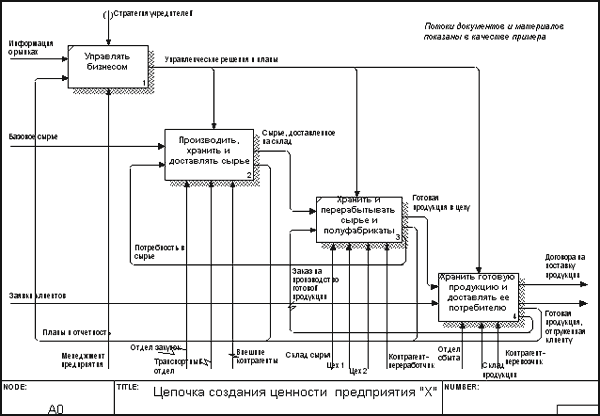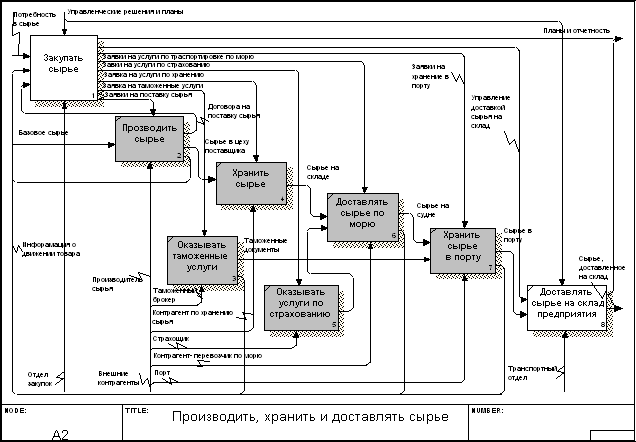Two ways to build business process models in IDEF0
Vladimir Repin Ph.D., Executive Director of FINEXPERT.RU LLC, Head. Department of Business Process Management of the National Educational Institution of Higher Professional Education "IEF "Synergy".
It is important to emphasize that when analyzing enterprise value chains, the identified business processes are, as a rule, cross-functional in nature. Many departments are involved in carrying out such processes. If, when building a model in IDEF0, we take the value chain as a basis, then the resulting model can rightfully be called a process model.
When trying to display the value chain presented in Figure 5 in the IDEF0 model, the question arises: how to display 16 business processes simultaneously on one diagram? This is not worth doing, because... the diagram will become difficult to read (not to mention violating the requirements of the standard). You need to decide how to group the processes so that, on the one hand, the chain is preserved, and on the other, not to overly complicate the diagram. In addition, you need to decide whether to display the business processes of purchasing, sales, financial management, etc. in this model. There may be several options for solving this problem. There is no single correct solution. Of course, it all depends on what goals we set for the model. Figure 6 shows an example of a model in IDEF0 built for the case under consideration.
Business processes in diagram A0 (Figure 6) are grouped into three categories based on an analysis of the movement of material flows - raw materials, semi-finished products, finished products. Below, as an example, a detailed representation of the process “Produce, store and deliver raw materials” is shown (see Figure 7).

Figure 6. Fragment of the IDEF0 model built on the basis of value chains. Diagram A0.
Figure 7 shows business processes performed by the enterprise in white, and business processes performed by external contractors in gray. It can be seen that the business process “Purchase raw materials”, in fact, manages all other business processes in the considered part of the value chain. This process is carried out by the Purchasing Department of the Supply Service. The “Transport Department” division also participates in this process (it is not shown in the organizational structure diagram in Figure 1). Although this unit is not part of the Supply Service, it performs part of the process under consideration. Thus, diagram A2 represents an “end-to-end” or cross-functional (one might even say inter-organizational) business process.
The reader may have a question: why was the business process of storing raw materials in the enterprise warehouse, performed by the Raw Materials Warehouse of the Supply Service, not included in diagram A2? This process was conditionally classified in the block of processes “Store and process raw materials and semi-finished products” (diagram A0, Figure 6). Here we touched upon the issue of defining the boundaries of “end-to-end” or cross-functional business processes. Since such processes are not localized within individual departments (or even organizations), determining their boundaries is quite subjective and depends on a number of criteria, which, as a rule, are developed when analyzing the company’s business based on established goals and objectives.

Figure 7. Fragment of the model in IDEF0, built on the basis of value chains. Diagram A2.
conclusions
We analyzed the value chains of several Russian companies using the IDEF0 standard and believe that it is quite suitable for these purposes with a correct and consistent methodological approach. In our opinion, the real problem is that enterprise specialists mix the two approaches presented above when building models in IDEF0. As a result, the resulting model contains both a description of the activities of departments (“local” processes) and elements of “end-to-end” processes. This mixture makes the model “loose” and significantly complicates its analysis and subsequent use for the purposes of reorganization, documentation and preparation for automation.
In addition to IDEF0, there are other forms of graphical representation of value chains, which will be discussed in future publications.
Moscow, February 2005
Some readers will probably say that this is too difficult for owners. However, our work experience shows that a professionally constructed model in IDEF0 can be used for discussion and decision-making not only at the level of specialists, but also at the level of owners.
The composition of functions and their distribution among employees are conditional. The table is given as an example.
Of course, this division of processes is subjective.
Unless, of course, we equate the activities of large structural divisions with business processes, as some authors do.
For more detailed methods of constructing value chains, see other articles by the author.
This is a problem not only with IDEF0, but also with any other method of graphically representing business processes.
 Discounted payback period
Discounted payback period Methodological aspects of project management
Methodological aspects of project management Scrum development methodology
Scrum development methodology